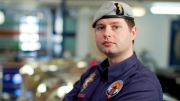
Bloodhound SSC mixes jet engines with children and live circuits
Last month the Bloodhound SSC team tested a Typhoon development jet engine using the electronic control system destined for the supersonic car. The test was held at Rolls Royce’s test facility and proved the system developed by Joe Holdsworth and REME Avionics WO2 (AQMS) Mark Edwin worked as designed.
The unlikely grouping of a former financial software programmer and an Army Avionics Instructor has proven a winning combination. Joe Holdsworth has developed the code with Mark Edwin bringing the concept into reality, building prototype electronics from his knowledge of military aircraft. The pair have created a control system the size of a sandwich box that has allowed the Bloodhound team to control the EJ200 engine as if were wrapped up in an aircraft.
The development has been no mean feat and has relied on the advice of Rolls Royce technical experts to get around the aircraft engine looking for airspeed, temperature and pressure inputs – it’s been a challenging project but the pair have been hugely successful.
Watch the engine being tested at http://youtu.be/PBJLxSkBNes
 WO2 (AQMS) Mark Edwin makes final adjustments to the EJ200 control circuits. By Major Oli Morgan WO2 (AQMS) Mark Edwin makes final adjustments to the EJ200 control circuits. By Major Oli Morgan |
135,000 horse power
 Rolls Royce’s Colin Smith and Bloodhound SSC Director Richard Noble OBE. By Stefan Marjoram
Rolls Royce’s Colin Smith and Bloodhound SSC Director Richard Noble OBE. By Stefan MarjoramSo, why is this ‘box of tricks’ so important? The Bloodhound SSC team are using one of the smallest most powerful jet engines of its type to get a competitive advantage in order to propel the eight-tonne British Land Speed contender though the sound barrier and beyond. The control system is needed to allow driver (Wg Cdr Andy Green) to throttle the jet engine in conjunction with a bespoke High Test Peroxide Rocket to get Bloodhound SSC to break through the supersonic barrier in South Africa in 2014. The combined power of the jet and rocket system is equivalent to 135,000 hp, six times greater than all of this season’s Formula 1 cars on the starting grid!
WO2 (AQMS) Mark Edwin has now handed the ‘electronics baton’ over to SSgt Henry ‘H’ Breed who was with the newly arrived REME team at Rolls Royce’s announcement of their involvement in the project. Colin Smith, Director of Engineering and Technology set out that that Rolls Royce would provide financial and technical support as well as 50 educational ambassadors to support Bloodhound SSC’s aim to inspire the next generation of kids into careers in STEM.
Big Bang Fair
At the event I got talking about the way the programming language worked with the EJ200 engine; SSgt ‘H’ Breed joked that the system could be taken one step further and integrated with a motion controller. This confirmed something that has interested me for sometime – the successful control system could be connected to something like an Xbox Kinect to turn the engine on with the wave of a hand. Now I must caveat that the team will be providing Andy Green with a throttle lever, which is much more physical, but it does illustrate the massive potential of technology with a little programming and electronics knowledge.
 Welbeck Students with REME SSgt Neil Gallagher.
Welbeck Students with REME SSgt Neil Gallagher.That evening my curiosity got the better of me and I spent a night reading more about motion sensing software to find that there are far more kids experimenting with Kinect technology than I had thought! This fact was reinforced at the Big Bang Fair with thousands of engaged kids mad about science and engineering and Bloodhound was there in force with the full sized show car as well as the entire REME team. Motion sensor technology was on display as were robots made by school kids and every kind of science – of note was the group from Welbeck Defence Sixth Form College who delivered a super remote controlled all-terrain vehicle and are off to carve out careers in the MoD when they graduate.
Reflecting on Big bang Fair and the Rolls Royce announcement – it was evident that there is serious interest in the technology and a sense that young people are much closer to the digital world i.e mobile devices than ever before and they are not scared to experiment.
Bloodhound Educational Ambassadors
 David Willetts MP with kids at the Bloodhound SSC stand at the Big Bang Fair.
David Willetts MP with kids at the Bloodhound SSC stand at the Big Bang Fair.Copyright Harry Dalton The Manufacturer
The exam question is: “how we harness young people’s natural interest in technology and point them towards a career in engineering or science?” Seeing the effect of the Bloodhound project on kids who came up to us on the stand in London convinced me that the work the Bloodhound Educational Ambassadors are doing is making a difference – the kids knew more about the car than the teachers/parents they dragged over.
Next blog (part two) will be straight after this one to make up for a bit of a delay. I will introduce the new REME team and the exciting work they be doing as the Bloodhound car comes together in the new Bloodhound Technical Centre in Avonmouth, Bristol.



